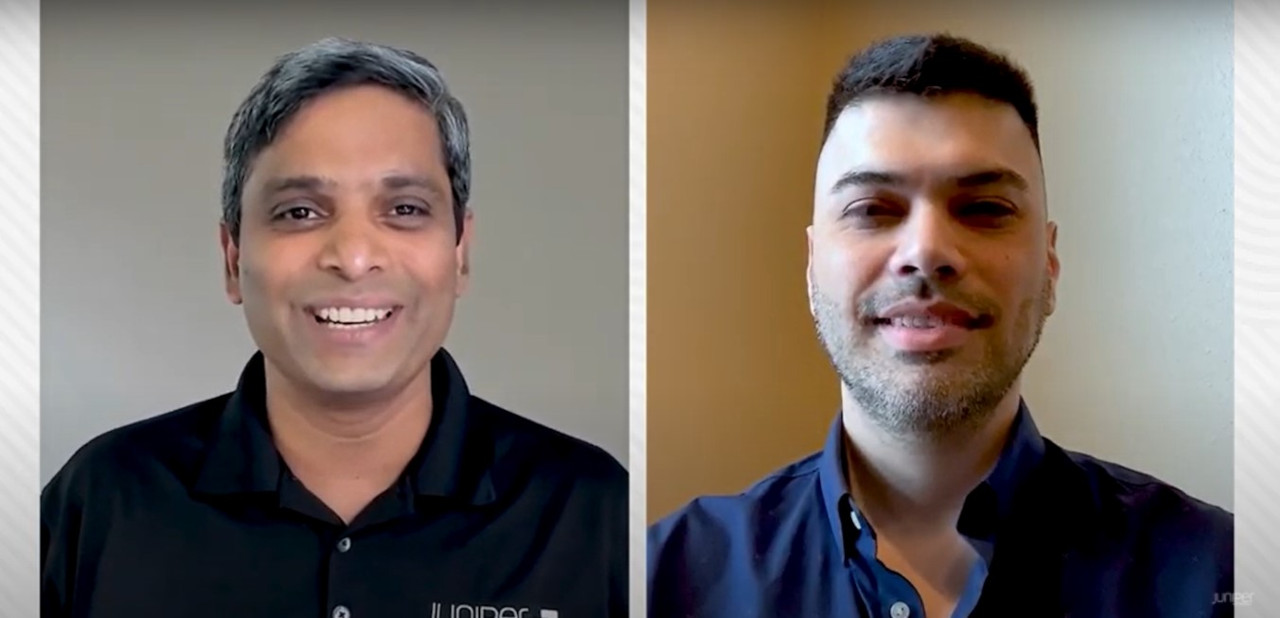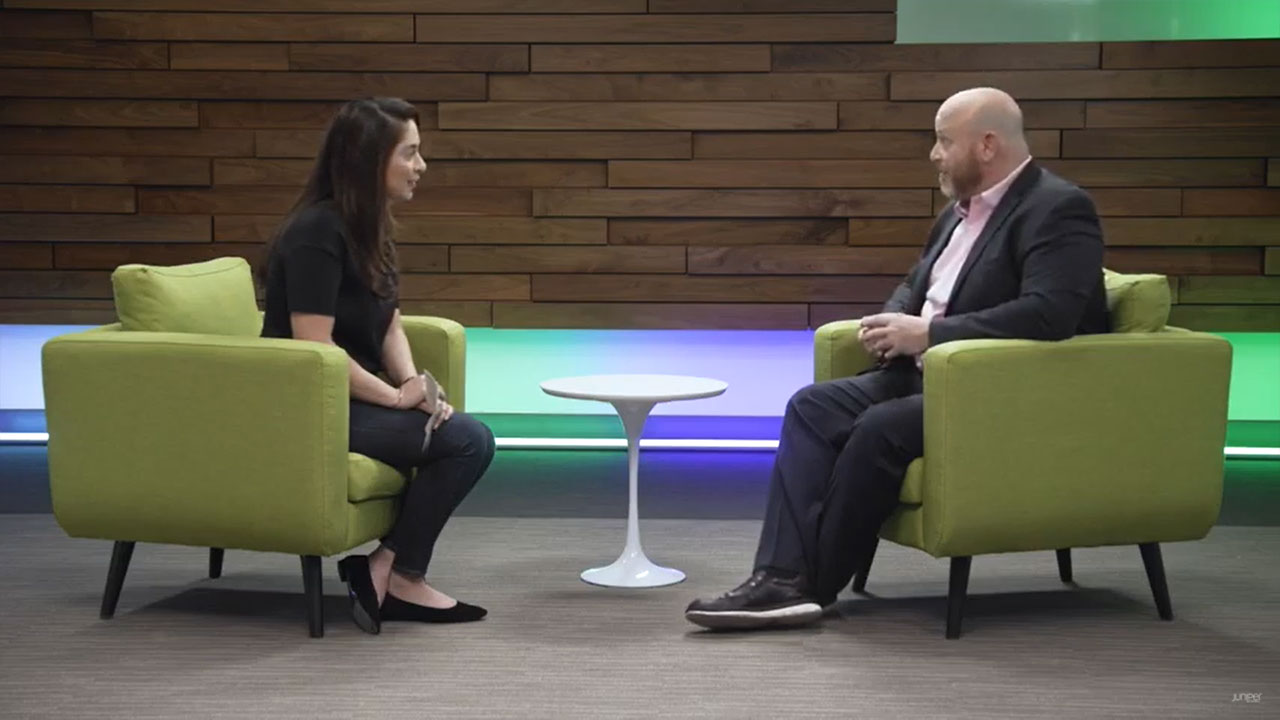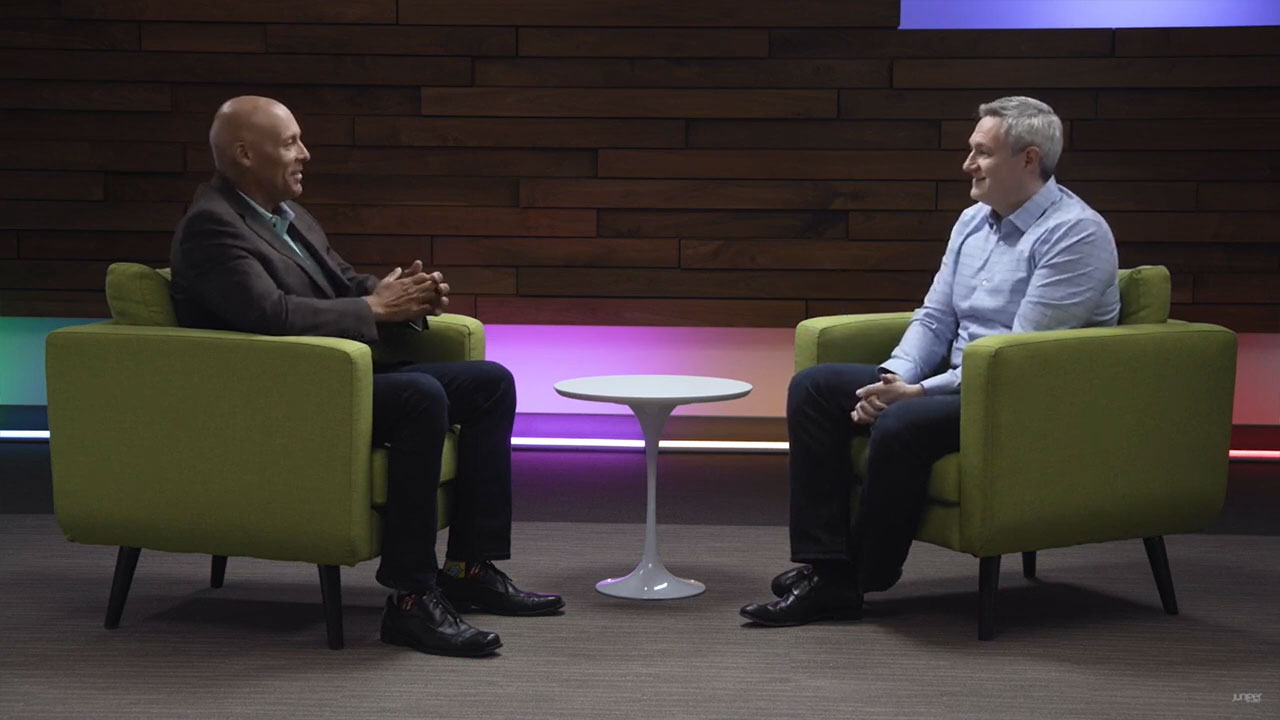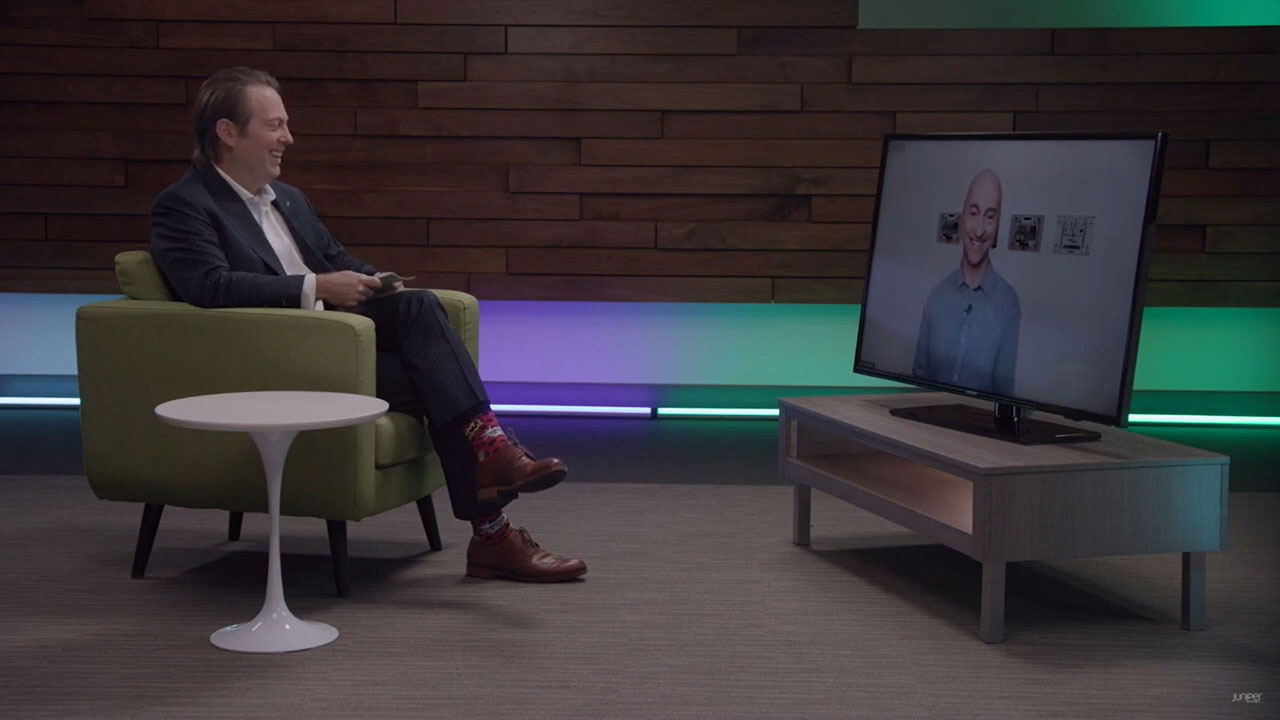The Open Evolution of the 5G Network | Juniper Global Summit 2022


Change is happening in the RAN – and that’s a good thing.
Today, the deployment of 5G infrastructure has seen a big push towards Open Radio Access Networks (Open RAN). To qualify as “open” RAN, equipment vendors must follow a set of industry-wide specifications published by the O-RAN Alliance.
In this eye-opening video from Juniper’s 2022 Global Summit, Raj Yavatkar, SVP and CTO of Juniper Networks, discusses the obstacles that come with an open or disaggregated RAN architecture with Marc Rouanne, EVP and CNO of Dish Wireless. Discover why overcoming these issues is vital for the growth of 5G, including Marc’s vision for Open RAN infrastructures within Dish, the future of Dish’s partnership with Juniper, and beyond.
Juniper is an active member of the O-RAN Alliance and contributes to six working groups and serves as chair and co-chair of the slicing and use-case task groups. We’re also an editor of RAN Intelligent Controller (RIC) specifications within the O-RAN Alliance.
You’ll learn
What makes a RAN “open” and how this network infrastructure benefits providers
Why Dish Wireless decided to use Open RAN to launch their nationwide 5G network
The importance of an application ecosystem in a successful O-RAN, according to Marc
Who is this for?
Host


Transcript
0:08 Hello, I'm Raj Yavatkar,
0:10 CTO for Juniper Networks.
0:13 Today, the development and deployment of 5G network infrastructure
0:17 has seen a big push towards what is known as Open RAN
0:20 or O-RAN mobile network architectures.
0:24 That architecture disaggregates the traditionally integrated style
0:28 . --> into
0:28 many different components that can be supplied by many different vendors.
0:34 The service providers and developers would integrate those together
0:38 to provide a completely new value.
0:40 They can take advantage of artificial intelligence
0:42 and machine learning in the process to optimize the networks.
0:46 We, at Juniper Networks,
0:47 believe that removing the obstacles
0:51 for making the O-RAN desegregated architecture happen,
0:55 is important for growth of 5G networks
0:57 and also created a thriving open ecosystem of application developers.
1:02 Today, I have the pleasure of talking with Marc Rouanne,
1:06 executive vice president and chief network officer at Dish Wireless.
1:10 Marc, thank you for joining me today.
1:13 Thank you, Raj.
1:15 First, starting with your vision for Open RAN based 5G networks
1:20 and how you want to see the industry develop,
1:23 and what Dish Wireless is trying to do.
1:27 We're lucky at Dish because we're starting a brand new 5G network
1:30 when the ecosystem is maturing towards Open RAN.
1:36 Open RAN, for us, is a lot of things.
1:38 It's a virtualized software first.
1:43 Basically, we consume the RAN software,
1:45 like in the cloud, microservices, and scalable.
1:50 All the things we see on the cloud now we can see on the RAN.
1:54 The second thing is it's open.
1:56 Open means that you can mix and match different vendors and ideas.
2:04 It accelerates innovation because some very good vendors maybe busy doing some things,
2:10 but then you have a new startup or a new enterprise that is coming with new ideas
2:14 and they can drop in and bring innovation to us.
2:18 On top of that, what Open RAN brings is that it allows other players like the silicon vendors
2:26 to inject their know-how and their investment capabilities.
2:31 For us, we have new cards, new accelerators,
2:34 new silicon, it's Christmas every day.
2:38 That's pretty cool to see.
2:40 In that context, if I may,
2:41 how do you see Juniper Networks playing a role and helping Dish Wireless?
2:47 We see Juniper as a thought leader in the industry.
2:51 We've been working with Juniper for almost two years now.
2:55 Juniper has been at the forefront when it comes to virtualization
3:00 of software starting with the routing capabilities vRouters
3:06 and sales side routers that are capable to run on what we love,
3:11 which is Kubernetes and cloud architectures.
3:16 I think Juniper is going further now in terms of automation
3:20 and application ecosystems and sees,
3:23 at least that's what I understand,
3:24 sees the power of AI and data so that you can put on top
3:28 of the classic networking capabilities and the classic networks,
3:33 you can put all these data-driven intelligence.
3:37 we share the same views.
3:39 You and I and our teams, we have had some very deep discussions,
3:43 and I think we share the same ambition there.
3:46 Good, thank you.
3:47 I think one of the things I also want to understand from you is that
3:50 O-RAN is completely new architecture, somewhat controversial.
3:55 Some of the vendors are not likely to accept it.
3:58 How do you see it evolving?
4:00 How do you see it happen in the industry?
4:04 I was at Barcelona for Mobile World Congress,
4:07 and I got convinced that everybody believes that virtual RAN and Open RAN is the way to go.
4:13 The debate is more like how fast can you go there if you have existing roadmaps,
4:19 existing chipsets, existing networks?
4:22 How do you embrace this new technology?
4:26 I don't think anybody is debating anymore that you want to be innovating in the cloud,
4:31 you want to use Kubernetes stacks,
4:33 you want to be scalable and microservice-based.
4:36 Even the more traditional vendors, I think,
4:39 have accepted and are investing in that direction.
4:43 It's going to be a journey because you are going to see different flavors.
4:46 People like us, because we're in Greenfield,
4:49 we can consume today but some more established players
4:54 and operators will take more time to consume.
4:57 They may decide to consume it for the enterprise, for the standard, you know what I mean?
5:00 There are different ways.
5:02 Over time, I have no doubt that the whole world is going to a virtualized software,
5:06 Open RAN, and cloud-native capabilities.
5:09 Now, that's good to know because we are betting on that.
5:11 I think our investments in O-RAN,
5:14 first time we are entering the mobile networks
5:15 with our RAN intelligence controller or cloud orchestration, and so on.
5:21 One question related to that is how critical you see
5:25 the application ecosystem developing to make O-RAN successful.
5:29 Well, the application ecosystem, as you call it,
5:32 is where the intelligence is going to be.
5:35 When you define a cloud RAN, Open RAN network,
5:39 you make it observable. The data is coming up and,
5:45 once the data is up, you can put applications of any form,
5:49 and a lot of them we have not even thought of or invented
5:52 that can make use of that data and then bring an extraordinary number of new benefits.
6:00 Like we've seen in the app stores for the smartphones,
6:04 it's pretty much unlimited what you can do once you have the compute and the data.
6:11 One of the most expensive resource in the 5G O-RAN architecture or otherwise is spectrum.
6:18 Do you see applications driving some new ways
6:21 of achieving spectrum utilization and efficiency?
6:26 Yes, actually,
6:28 I'm a technology geek and I love demonstrations and experimentation.
6:33 I've seen several times, in my life,
6:35 applications that were capable of improving the spectrum all the way up to or %,
6:42 for very specific applications.
6:44 Which is, for an engineer like me seriously, %, %.
6:50 Of course, we're not going to get this across the board, but even if we can,
6:55 on average, get a few percent of spectrum efficiency
6:59 because we all know the price and the cost of spectrum,
7:02 this is an incredible capability.
7:06 I would start with that, the spectrum efficiency for drones or for transportation
7:11 or for some very specific use cases where you can define
7:16 and adapt your scheduler and all your channel estimation
7:21 to actually what's happening because,
7:24 with the data, you can learn much more in-depth.
7:29 What about the slicing that happens in the radio access network
7:33 but also slicing happens in transport and core?
7:35 For example, we, at Juniper,
7:38 we are one the first one to support transport slicing and core network slicing.
7:43 What's your view of slicing,
7:44 the role it plays both in RAN as well as on end-to-end point basis?
7:49 Yes, slicing will happen all the way from the services
7:54 to the core of the transport and the RAN.
7:57 Actually, you know what?
7:58 I think the link is a formidable prototype of intelligent controllers,
8:03 but I expect to see the same capabilities for the transport, having intelligent controllers.
8:08 I know you guys are investing there and have a lot of assets there,
8:15 but I expect to see it at the cloud optimization layer,
8:20 having intelligent controllers that can optimize your resources at the cloud level,
8:24 and all the way for slices during the day, during the night,
8:28 depending on the geographies.
8:32 As I said, it seems to be pretty much in limited the type of things you can do.
8:37 One other aspect of this open ecosystem
8:40 and application development could be impact on sustainability.
8:44 How do we make networks more sustainable?
8:46 Do you have any thoughts on that with respect to what we could do?
8:49 Yes, traditionally, wireless networks have been designed for peak,
8:56 either peak during the day so you have like one hour during
8:59 which people consume more because they commute or they are home,
9:03 or for certain events like New Year's Eve,
9:08 which makes mobile networks pretty much empty
9:13 in other parts of the day during the night or during empty seasons.
9:19 With intelligent data and scalability and cloud-native,
9:23 you can scale up and down, you can steer the traffic,
9:26 you can steer the compute like we do in the cloud today.
9:30 Then you have a much more sustainable network
9:33 where you transmit in a much more efficient way,
9:36 and you can take down the power of the radios.
9:42 They consume a lot of power there on top of the mast.
9:46 You can adapt.
9:48 You can also steer the traffic.
9:49 For example, upgrading smartphones,
9:52 you don't want to do that during the busy hour.
9:54 You want to do that when the network is less busy or you want to offload it on Wi-Fi.
10:02 Once you have all these visibility and those slices and use cases,
10:05 yes, you can really have an impact on the cost of OPEX
10:11 and the power consumption of the network.
10:12 Okay.
10:14 I want to give you last word, Marc, with respect to,
10:17 just tell us about your vision and roadmap for Dish Wireless.
10:21 Where do you want to be in the next two years and what do we expect?
10:24 How Juniper Networks can also be there as a partner to help you?
10:29 I'll go back to the discussion you and I we had a few weeks back.
10:33 Today, I consider that we have done a classic cloud-native network,
10:37 where we can distribute advanced services based on the smartphones
10:43 and other classic devices.
10:45 But the next focus,
10:46 what we are discussing and we are discussing that together is
10:49 when you go to the enterprise,
10:51 how do you equip your SD-WAN with advanced mobility?
10:55 How do you have equipped with advanced security?
10:58 How do you give seamless remote access to SD-WAN
11:04 or facilities with people that are working remotely?
11:08 Then you move this capability to machines and sensors.
11:14 A lot of the internet capabilities today are still managed by devices
11:19 that are connected to the internet.
11:21 With 5G,
11:22 we can expand all the things we are doing to any device
11:26 that can be connected through wireless,
11:30 whatever the wireless may be, Wi-Fi, 5G,
11:33 or any other CB or C-band capabilities.
11:36 That's where we focusing now,
11:39 exploring those capabilities because the technology is there
11:43 and now it's how you consume it and how you expose it
11:46 and how you combine and integrate it to serve enterprises.
11:51 To say the least, I think, we, at Juniper Networks,
11:54 are excited to join you in your journey.
11:57 I hope you all the best and thank you for joining me today.
12:00 Thank you for your support and your thought leadership.
12:04 This is helping us a lot understanding where we need to go.
12:08 Thank you.














